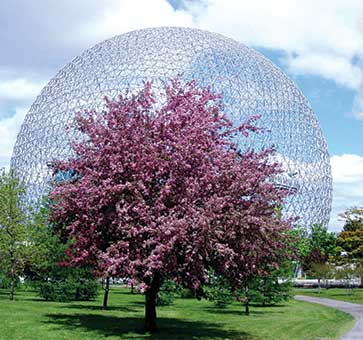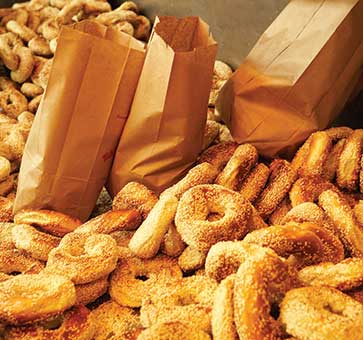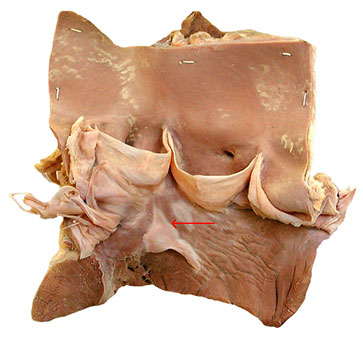Say "Bonjour-Hi!" to Magnifique Montreal
By Beth Weinhouse
This European-feeling city just to our north has a vibrant cultural scene, fabulous restaurants, and spectacular natural surroundings that make it well worth crossing the border for. (There are special sights for doctors, too.)

Alto
“Bonjour-hi!” is the greeting you’ll hear everywhere in Montreal, and it nicely sums up the vibe in this exciting, cosmopolitan city. While the city’s language—and the language in all of Quebec province—is officially French, most inhabitants speak perfect English, and signs appear in both languages. That makes the city both foreign-feeling and easy to navigate for Americans. (Yet if you choose to practice your French, beware: the locals will understand you perfectly, but their French isn’t the Parisian French you probably learned in school.) The advantages to crossing our northern border are numerous: fabulous French food, world-class art and architecture, beautiful natural surroundings. . .and even destinations of special interest to doctors.
The most distinct feature of the city is the mountain smack in the middle of downtown—Mount Royal, which gives the city its name. You can drive to the top, or walk the 400-step staircase that begins on the corner of Peel Street and Pine Avenue. Either way, the view at the summit is worth it. “And don’t forget, that’s where [the real] Anna in The King and I was buried,” says Ross Feldman, MD, chair of medicine, Health Sciences Centre, St. John’s, Newfoundland. (Deceased in 1915, Anna Harriette Leonowens is interred at the Mount Royal Cemetery on the north slope of the mountain.)
There’s a lot to see in the city of 1.7 million people (3.5 million if you include the surrounding area), situated on an island in the middle of the St. Lawrence River. It’s easy to navigate on foot or by subway, bus, or cab. It’s big enough to have distinct neighborhoods, but not so big as to be overwhelming. We asked a few current and former medical Montrealers (or Montréalais in French) for their recommendations.
“When I’m organizing a conference, and there are people who haven’t visited the city before, I always encourage people to do what you won’t get or won’t get as well anywhere else,” says Christopher Lyons, head librarian at the Osler Library of the History of Medicine at McGill University.

Old Montreal
Old Montreal is an ideal area for visitors to make their temporary home during their stay. Lyons recommends the Auberge Bonaparte. “It’s a small hotel with a fantastic French restaurant,” he says. “It’s right around the corner from the Notre-Dame Basilica.”
Dr. Feldman seconds the recommendation of Old Montreal as a great place to stay. “It has a great feel to it, with lots of little art shops,” says Dr. Feldman, who has family in the city and tries to visit as often as possible. He recommends the Hotel Place d’Armes, the Hotel Le St. James, and the Hotel Nelligan. For those who prefer large hotels, all the major chains—including Ritz-Carlton, Sofitel, Omni, W, Hilton, Marriott, Westin, etc.—have hotels in the downtown area.
If you love visiting museums, Montreal won’t disappoint. The Montreal Museum of Fine Arts (Musée des Beaux-Arts de Montréal), on Sherbrooke Street, a main avenue bisecting the downtown, is hard to miss. Out front is a gigantic glass sculpture by the artist Chihuly, with bright yellow and red tendrils snaking in all directions. Inside, the museum has a permanent collection of masters like van Gogh, Dali, Picasso, and Matisse, as well as collections of Canadian art, including the work of the Inuit people who inhabit the Arctic region of the country.
Not far away on Sherbrooke, on the McGill University campus, is the Redpath Museum of Natural History. The quirky and eclectic collection of ancient and modern organisms, minerals, and ethnological artifacts in the small museum will delight both adults and curious children.

The Montreal Biosphere (not to be confused with the Biodome), a museum dedicated to environmental issues.
Then there’s the Montreal Biodome, in a building originally constructed as a velodrome for the 1976 Olympics. Inside, the Biodome contains living replicas—including vegetation and some wildlife—of four ecosystems. Visitors can walk through a South American rain forest, a North American wilderness forest, Arctic/Antarctic polar regions, and a river ecosystem modeled on the St. Lawrence River. For obvious reasons, the tropical rainforest’s heat and humidity feel especially wonderful when visiting during a frigid Canadian winter.
Délicieux!
Perhaps because of their French ties, Montrealers are proud of the local cuisine, and rightly so. The options for elegant and casual dining are far too numerous to take advantage of during a short trip. . .but it’s fun to give it your best shot.
For breakfast, try one of these three options:
1. Visit almost any of the cafés dotting the city to enjoy the kind of flaky, buttery croissants usually available only in Paris. Try Patisserie de Gascogne in the Westmount section of town. The charming decor and tarts, gâteaux, breads, and pastries in the bakery cases will make you think you’re in France.

Fresh-baked bagels at the famous Fairmount Bakery in the Plateau district.
2. Try a very distinctive Montreal bagel. “Montreal bagels are different than bagels anywhere else in the world,” says Dr. Feldman, “and you can get them right out of the oven.” Smaller, thinner, sweeter, and denser than their New York counterparts, with a larger hole in the middle and a crunchier outside, the bagels usually come topped with sesame seeds ("white seed" in the local lingo) or poppy seeds (“black seed”). The two best-known purveyors are Fairmount and St.-Viateur, both of which sell the bagels fresh 24 hours a day, and both located in the district east of Mount Royal, called le Plateau. Stroll along rue Saint-Denis and Saint-Laurent Boulevard, the two main commercial streets in the neighborhood, while munching a fresh, warm bagel.
3. Stop at Tim Hortons, Canada’s equivalent of Dunkin' Donuts or Krispy Kreme. To find one, ask a local where the nearest “Timmy’s” is. And if you like your coffee light and sweet, you can order like a local, too. Ask for a “double-double,” which means coffee with two creams and two sugars.
Here are three good options for midday fare:
1. Go native, and try Quebec-favorite poutine for lunch. “No one should leave Quebec without having tried poutine,” says Dan Deckelbaum, MD, a surgeon, director of the Global Health Program, and professor in the division of trauma surgery at McGill University’s medical school. “It’s amazing. It’s especially great in winter, when it’s so cold outside.”
The traditional version of poutine is a plate (or bowl) of french fries, covered in brown gravy, with cheese curds on top. New versions of the dish include fries topped with chicken, bacon, smoked meat, sausage. . .even foie gras, caviar, or truffles. Montreal outlawed street food carts in 1947, and since then the city has spawned small, greasy-spoon type restaurants that sell poutine, as well as the small hot dogs that Montrealers call “steamies” and other kinds of street fare. But even fast food chains like McDonald’s and Burger King sell poutine in the city, and high-end restaurants often serve upscale versions.

Fresh local produce at the Jean-Talon market in the Little Italy district.
2. Visit one of the large indoor/outdoor food markets—Atwater and Jean-Talon—to browse the local bounty and sample artisanal food offerings for lunch. The Atwater market is in the southwest part of the city near the Lachine Canal, while Jean-Talon is in the middle of Montreal’s Little Italy neighborhood. Both enormous markets feature produce from local farmers, as well as small shops and stands selling flowers, spices, oils, cheese, meat, fish, baked goods, regional and ethnic cuisine, maple products, etc. You can wander around and try various international cuisines from the many vendors and small cafés.
3. If you’re really hungry, make a meal of Montreal’s famous “smoked meat,” a kind of cross between New York-style pastrami and corned beef. "If you miss the Stage Deli in New York, you can create the same kind of meal at Schwartz’s, a Montreal landmark," says Dr. Feldman. "That’s where you go for traditional Montreal smoked meat.” Be prepared to wait in line to get into the tiny restaurant. If you’re impatient, the smoked meat is also available packaged and ready to go.
Now it’s dinner time, and the options are even more daunting. TripAdvisor lists 4500 restaurants in the city. Here are a few recommendations. . .but realize that there are very many more fine restaurants in Montreal than are possible to list here.
“If you want to look for authentic French, I recommend Europea,” says Dr. Feldman, adding that it’s always high up in the Trip-Advisor ratings. The restaurant is extremely popular, so if you plan to visit, try to make a reservation (you can do it on Open Table) even before you leave the States.
Dr. Feldman also recommends Moishes, a 75-year-old steakhouse on Saint-Laurent Boulevard. And Gibby’s for steak and seafood, located in a 200-year-old stone building in Old Montreal.
One last word about food in Montreal, and it’s a sweet one: maple. Quebec produces about three-quarters of the world’s maple syrup, and the city is crazy for it. During maple-tree-tapping season—February to April—you can find maple on menus all over the city, and maple for sale everywhere. Besides syrup, there’s maple sugar, candy, cookies, muffins, donuts, and even soap and candles. Little sugar shacks—called cabanes à sucre—spring up to offer all kinds of maple products, which make excellent souvenirs. Les Délices de l'Erable, a maple boutique and mini-museum on Rue St. Paul in the Old City, is a good place for maple souvenirs year-round.
Work it Off
Enough about food. In fact, at this point you probably want to burn off all the delicious calories you've consumed. Montreal and the surrounding areas provide a lot more workout options than simply walking up and down Mount Royal all day.
To start with, Montreal was one of the first cities to get a bike-share program. Bixi Bikes has over 5000 bicycles throughout the city, and over 400 stations to rent and return them to. “You can pretty much ride around the whole island,” says Dr. Deckelbaum. “It’s a beautiful ride. . .or walk or run. You’d need to be in really good shape to get all the way around, but you can do a decent segment of it, or the downtown core, in a very relaxed half day.”
For less urban pursuits, the Laurentian mountains are an easy drive away; the resort town of Mont Tremblant is less than two hours away by car. This pedestrian village feels like a Swiss ski town, with narrow cobblestone streets, numerous shops, and endless places to snack or dine. You can ski right into some of the hotels, then relax in a sauna or swim in an outdoor pool. Mont Tremblant is a lovely destination in the summer, too. Active travelers can hike and climb, swim, boat, or play tennis, while those who just prefer to relax can visit one of the many spas or shop the village streets. Among the various hotels, condos, and resorts to stay in, two that stand out are the Fairmont Tremblant and the Westin Resort and Spa Tremblant.
For a city spa, Bota Bota—in a ferryboat anchored in the Old Port on the St. Lawrence River—offers a unique experience. “You can sit there in the hot tub, looking over the city, when it’s minus 30 degrees [Celsius] outside. It’s a pretty surreal experience,” says Dr. Deckelbaum.
Yes, the freezing winter is “character-building,” as one current resident puts it. But the elaborate underground city means you can do a lot of shopping and sightseeing without emerging above ground. And you shouldn’t need the excuse of a strong U.S. dollar to go shopping. Besides endless varieties of maple syrup and other products, good souvenirs include:
➼Ice wine—a dessert wine produced from grapes that have been allowed to freeze on the vine.
➼Hudson’s Bay point blankets—striped wool blankets modeled after those traded with the First Nations (Native Americans) for beaver pelts in the 18th and 19th centuries. The blankets—and coats, totes, backpacks, and more—are sold in the Hudson’s Bay department stores, known as The Bay or La Baie.
➼First Nations and Inuit art—prints, carvings, baskets, glasswork, jewelry and masks crafted by the native people who inhabit Canada's north.
Last but not least, if you’re planning your trip, don’t forget your passport. It’s been over a decade since Americans could cross the border—in either direction—with just a driver’s license and birth certificate.
*****
Three Montreal Destinations Just for Doctors
The phrase "busman's holiday" refers to a bus driver taking a vacation. . . and traveling by bus. So what's a doctor's holiday? Relax, we're not suggesting you start treating patients while you're away. But even on holiday you might enjoy these three Montreal attractions that showcase fascinating aspects of medical history.
1. The Osler Library of the History of Medicine at McGill University
Renowned physician Sir William Osler (1848-1919) created the first medical residency program and was one of the founders of Johns Hopkins Hospital. A McGill graduate and later a professor there, he left his impressive medical books collection to the university upon his death. "The oldest item in the museum is 2700 years old," says Christopher Lyons, head librarian. "It's an Assyrian clay tablet, ophthalmological, and it says, 'Give the patient the best beer!'" Inside the 1960s building is the original 1929 oak-paneled library room, which was moved when the library relocated. The collection of about 100,000 volumes also includes medieval manuscripts, beautifully illustrated anatomical atlases, bibliographies, and vintage pharmaceutical ads. Visitors are welcome.
2. The Maude Abbot Medical Museum at McGill University

The Holmes Heart
3. Musee des Hospitalieres de L'Hotel-Dieu de Montreal
This museum, on Pine Street downtown, illuminates some of Quebec's health history: specifically, the hospital rebuilt and served by a religious order--the Religious Hospitaliers of Saint Joseph--to serve the sick poor of the area. The first Hospitaliers arrived in Montreal in 1659, and they are still active in the city today. The museum's collection contains 20,000 artifacts kept by the order over the centuries. In addition to the museum exhibits, the garden and architecture--which includes the 17th century staircase at the museum's entrance--are also worth a look.
